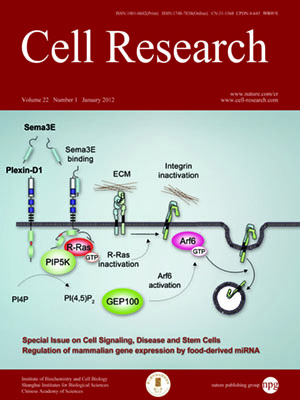
Volume 22, No 1, Jan 2012
ISSN: 1001-0602
EISSN: 1748-7838 2018
impact factor 17.848*
(Clarivate Analytics, 2019)
Volume 22 Issue 1, January 2012: 90-106
REVIEWS
Normal and disease-related biological functions of Twist1 and underlying molecular mechanisms
Qian Qin1, Young Xu2, Tao He3, Chunlin Qin4 and Jianming Xu1,3
1Department of Molecular and Cellular Biology, Baylor College of Medicine, 1 Baylor Plaza, Houston, TX 77030, USA
2Yale University, New Haven, CT 06511, USA
3Luzhou Medical College, Luzhou 646000, China
4Department of Biomedical Sciences, Texas A&M Health Science Center, Baylor College of Dentistry, Dallas, TX 75246, USA
Correspondence: Jianming Xu,(jxu@bcm.edu)
This article reviews the molecular structure, expression pattern, physiological function, pathological roles and molecular mechanisms of Twist1 in development, genetic disease and cancer. Twist1 is a basic helix-loop-helix domain-containing transcription factor. It forms homo- or hetero-dimers in order to bind the Nde1 E-box element and activate or repress its target genes. During development, Twist1 is essential for mesoderm specification and differentiation. Heterozygous loss-of-function mutations of the human
Twist1 gene cause several diseases including the Saethre-Chotzen syndrome. The Twist1-null mouse embryos die with unclosed cranial neural tubes and defective head mesenchyme, somites and limb buds. Twist1 is expressed in breast, liver, prostate, gastric and other types of cancers, and its expression is usually associated with invasive and metastatic cancer phenotypes. In cancer cells, Twist1 is upregulated by multiple factors including SRC-1, STAT3, MSX2, HIF-1
α, integrin-linked kinase and NF-κB. Twist1 significantly enhances epithelial-mesenchymal transition (EMT) and cancer cell migration and invasion, hence promoting cancer metastasis. Twist1 promotes EMT in part by directly repressing E-cadherin expression by recruiting the nucleosome remodeling and deacetylase complex for gene repression and by upregulating Bmi1, AKT2, YB-1, etc. Emerging evidence also suggests that Twist1 plays a role in expansion and chemotherapeutic resistance of cancer stem cells. Further understanding of the mechanisms by which Twist1 promotes metastasis and identification of Twist1 functional modulators may hold promise for developing new strategies to inhibit EMT and cancer metastasis.
Cell Research (2012) 22:90-106. doi:10.1038/cr.2011.144; published online 30 August 2011
FULL TEXT | PDF
Browse 2448


